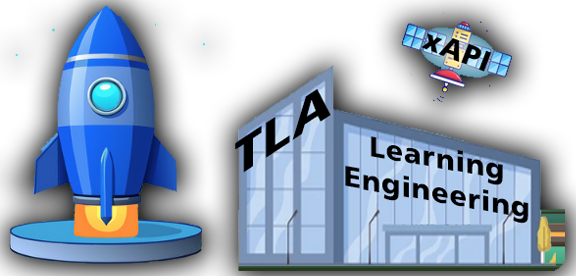I was thinking about some recent work where production/performance analytics from production lines were being merged with training information. The scaffolding for analytics dashboards was arrived at through stakeholder exercises applying Will Thalheimer's LTEM (Learning-Transfer Evaluation Model).
In my flight simulation career, we were hyper-focused on advancing and reinforcing the pilot/warfighter's skill set. This meant honing their ability to process flight dynamics and threat assessments in real-time, while building that crucial "muscle memory" to optimally execute their roles under pressure. It's all about turning complex, high-stakes scenarios into second nature, reducing errors and boosting efficiency.

One highlight was my opportunity to support DHL in developing part-task trainers for their B727 and DC8 aircraft. We zeroed in on emergency procedures, critical startup/shutdown sequences, and normal operations – creating targeted assessments and continued exercises to ensure crews could handle anything thrown their way. These trainers weren't just about rote practice; they were designed to simulate real-world stresses and measure performance improvements over time.
In a different application of human performance i worked on related to Firefighter Incident Command, the training and performance criteria involved Conditions, Actions, and Needs. The radio transmission called “CAN” reports were used in After Incident Reviews to validate correct actions and consider lessons learned to apply to future operations.
Fast-forward to today's technology landscape, and things get even more exciting. Standards like xAPI (Experience API) allow training systems to communicate at a granular level, capturing a student's actions within specific contexts. This is a game-changer for flight simulation training, where every decision in the cockpit can be tracked and analyzed to optimize learning paths. But xAPI doesn't stop there – we can enrich it with additional metrics from various sources. In military settings, eye-tracking and other biosensors provide insights into where pilots are focusing during simulations, helping identify cognitive overload or lapses in attention. On the commercial side, production data or feeds from vehicle OBD (On-Board Diagnostics) sensor buses add layers of real-time performance info building context from real world data the "actor" is influencing. Collectively, these data sources create a "noisy" accumulation of xAPI statements for the student (aka the "Actor"), which can be overwhelming but incredibly powerful if managed right.
The concepts of Crew Resource Management (CRM) come to mind. The military and commercial aviation have a strong focus on the discipline as well as a comprehensive review process of any accident or mishap. How can this be right-sized for any Human Performance Optimization (HPO) challenge? I highly suggest checking out the Total Learning Architecture (TLA). Developed by the Advanced Distributed Learning (ADL) Initiative and incorporating elements becoming IEEE standards, TLA is a framework that integrates various learning technologies, data standards, and analytics to create a seamless, enterprise-level ecosystem for training. It builds on xAPI and other pillars to handle that "noisy" data, enabling personalized HPO by tracking learner competencies, resources, and performance in real-time. In contexts like pilot training or CRM, TLA could help unify biosensors, sim data, and team dynamics into actionable insights, ultimately enhancing safety and effectiveness.
What do you think? Have you worked with xAPI, TLA, or similar tech in HPO? Share your experiences, challenges, or ideas below – let's optimize this discussion!
In my flight simulation career, we were hyper-focused on advancing and reinforcing the pilot/warfighter's skill set. This meant honing their ability to process flight dynamics and threat assessments in real-time, while building that crucial "muscle memory" to optimally execute their roles under pressure. It's all about turning complex, high-stakes scenarios into second nature, reducing errors and boosting efficiency.

One highlight was my opportunity to support DHL in developing part-task trainers for their B727 and DC8 aircraft. We zeroed in on emergency procedures, critical startup/shutdown sequences, and normal operations – creating targeted assessments and continued exercises to ensure crews could handle anything thrown their way. These trainers weren't just about rote practice; they were designed to simulate real-world stresses and measure performance improvements over time.
In a different application of human performance i worked on related to Firefighter Incident Command, the training and performance criteria involved Conditions, Actions, and Needs. The radio transmission called “CAN” reports were used in After Incident Reviews to validate correct actions and consider lessons learned to apply to future operations.
Fast-forward to today's technology landscape, and things get even more exciting. Standards like xAPI (Experience API) allow training systems to communicate at a granular level, capturing a student's actions within specific contexts. This is a game-changer for flight simulation training, where every decision in the cockpit can be tracked and analyzed to optimize learning paths. But xAPI doesn't stop there – we can enrich it with additional metrics from various sources. In military settings, eye-tracking and other biosensors provide insights into where pilots are focusing during simulations, helping identify cognitive overload or lapses in attention. On the commercial side, production data or feeds from vehicle OBD (On-Board Diagnostics) sensor buses add layers of real-time performance info building context from real world data the "actor" is influencing. Collectively, these data sources create a "noisy" accumulation of xAPI statements for the student (aka the "Actor"), which can be overwhelming but incredibly powerful if managed right.
The concepts of Crew Resource Management (CRM) come to mind. The military and commercial aviation have a strong focus on the discipline as well as a comprehensive review process of any accident or mishap. How can this be right-sized for any Human Performance Optimization (HPO) challenge? I highly suggest checking out the Total Learning Architecture (TLA). Developed by the Advanced Distributed Learning (ADL) Initiative and incorporating elements becoming IEEE standards, TLA is a framework that integrates various learning technologies, data standards, and analytics to create a seamless, enterprise-level ecosystem for training. It builds on xAPI and other pillars to handle that "noisy" data, enabling personalized HPO by tracking learner competencies, resources, and performance in real-time. In contexts like pilot training or CRM, TLA could help unify biosensors, sim data, and team dynamics into actionable insights, ultimately enhancing safety and effectiveness.
What do you think? Have you worked with xAPI, TLA, or similar tech in HPO? Share your experiences, challenges, or ideas below – let's optimize this discussion!
Last edited:
